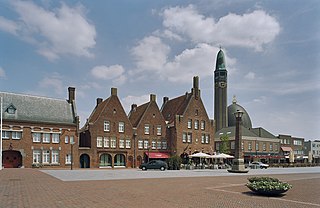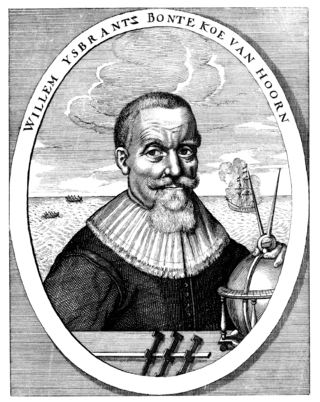Related Research Articles

Waalwijk is a municipality and a city in the southern Netherlands. It had a population of 48,815 in 2021 and is located near the A59 and N261 motorways. The villages of Capelle, Vrijhoeve-Capelle, Sprang and Waspik together with the city of Waalwijk form the municipality of Waalwijk. The city has an old town center, which has recently been modernized.

Drechterland is a municipality in the Netherlands, in the province of North Holland and the region of West-Frisia. The municipality was formed in 1979, in a merger of the former municipalities of Hoogkarspel, Westwoud and Oosterblokker. Its original name, Bangert, was changed to "Drechterland" in 1980. In 2006, the former municipality of Venhuizen was added to Drechterland.

Enkhuizen is a municipality and a city in the Netherlands, in the province of North Holland and the region of West-Frisia.

Hoorn is a city and municipality in the northwest of the Netherlands, in the province of North Holland. It is the largest town and the traditional capital of the region of West Friesland. Hoorn is located on the Markermeer, 20 kilometers (12 mi) east of Alkmaar and 35 kilometers (22 mi) north of Amsterdam. The municipality has just over 73,000 inhabitants and a land area of 20.38 km2 (7.87 sq mi), making it the third most densely populated municipality in North Holland after Haarlem and Amsterdam. Apart from the city of Hoorn, the municipality includes the villages of Blokker and Zwaag, as well as parts of the hamlets De Bangert, De Hulk and Munnickaij.

Willem Cornelisz Schouten was a Dutch navigator for the Dutch East India Company. He was the first to sail the Cape Horn route to the Pacific Ocean.

Opperdoes is a village in the Dutch province of North Holland. It is a part of the municipality of Medemblik, and lies about 12 km north of Hoorn. It has a certain fame for its local variety of potatoes, "Opperdoezer Ronde".

Willem Ysbrandtszoon Bontekoe was a skipper in the Dutch East India Company (VOC), who made only one voyage for the company (1618–1625). He became widely known because of the journal of his adventures that was published in 1646 under the title Journael ofte gedenckwaerdige beschrijvinge van de Oost-Indische reyse van Willem Ysbrantsz. Bontekoe van Hoorn, begrijpende veel wonderlijcke en gevaerlijcke saecken hem daer in wedervaren.

The Netherlands Film Festival is an annual film festival, held in September and October of each year in the city of Utrecht.

Stoomvaart Maatschappij Nederland or SMN, also known as the Netherland Line or Nederland Line, was a Dutch shipping line that operated from 1870 until 1970, when it merged with several other companies to form what would become Royal Nedlloyd.

Ferdinand Augustijn Snellaert was a Flemish writer.

Pieter Florentius Nicolaas Jacobus Arntzenius was a Dutch painter, water-colourist, illustrator and printmaker. He is considered a representative of the younger generation of the Hague School.

Wilhelmus Johannes Franciscus Nuyens, better known as Willem Jan Frans Nuyens, was a Dutch historian.

Joan van Hoorn (1653–1711) was Governor-General of the Dutch East Indies from 1704 until 1709.

The Haarlem Guild of Saint Luke was first a Christian, and later a city Guild for various trades falling under the patron saints Luke the Evangelist and Saint Eligius.

Willem Fredrik Jacob Mörzer Bruyns,, is a Dutch historian of navigational science, specializing in the history of navigational instruments; he has also published on the history of the Dutch in the Arctic in the nineteenth century. He rose to be Senior Curator of Navigation at the Nederlands Scheepvaartmuseum before his retirement in 2005. Since 1972, Mörzer Bruyns published several books and a hundred-and-fifteen articles in scholarly journals, on the history of navigation and navigational instruments, and on the exploration of the Dutch in the Arctic, in the nineteenth century. He wrote seventy-five book reviews on these subjects in scholarly journals.

Java Ho!: The Adventures of Three Boys Amid Fire, Storm and Shipwreck is a juvenile fiction novel by Dutch author Johan Fabricius, first published in 1924.

Barbara Ogier was a Flemish playwright of De Olijftak, a chamber of rhetoric in Antwerp. Her motto was "Deugd voeght yder".

Frans Jozef Peter van den Branden was a Belgian playwright, art historian, civil servant, educator and archivist. He wrote in the Dutch language. He is now known mainly for his art historical works, which mainly dealt with the history of the Antwerp school of artists and Antwerp poets and dramatists linked to the local chambers of rhetoric. He also co-authored the Biographisch woordenboek der Noord- en Zuidnederlandsche letterkunde with Johannes Godefridus Frederiks, a biographical dictionary of writers from the Netherlands and Belgium and their predecessor states.
Anarchism in the Netherlands originated in the second half of the 19th century. Its roots lay in the radical and revolutionary ideologies of the labor movement, in anti-authoritarian socialism, the free thinkers and in numerous associations and organizations striving for a libertarian form of society. During the First World War, individuals and groups of syndicalists and anarchists of various currents worked together for conscientious objection and against government policies. The common resistance was directed against imperialism and militarism.
The historiography of the Eighty Years' War examines how the Eighty Years' War has been viewed or interpreted throughout the centuries. Some of the main issues of contention between scholars include the name of the war, the periodisation of the war, the origins or causes of the war and thus its nature, the meaning of its historical documents such as the Act of Abjuration, and the role of its central characters such as Philip II of Spain, William "the Silent" of Orange, Margaret of Parma, the Duke of Alba, the Duke of Parma, Maurice of Orange, and Johan van Oldenbarnevelt. It has been theorised that Protestant Reformation propaganda has given rise to the Spanish Black Legend in order to portray the actions of the Spanish Empire, the Army of Flanders and the Catholic Church in an exaggerated extremely negative light, while other scholars maintain that the atrocities committed by the Spanish military in order to preserve the Habsburg Netherlands for the Empire have historically been portrayed fairly accurately. Controversy also rages about the importance of the war for the emergence of the Dutch Republic as the predecessor of the current Kingdom of the Netherlands and the role of the House of Orange's stadtholders in it, as well as the development of Dutch and Belgian national identities as a result of the split of the Northern and Southern Netherlands.
References
- 1 2 Leenders, Jos (1997). "Vereeniging voor Volksvermaken te Hoorn 1870-1896". Historisch Tijdschrift Holland (4–5): 257–73. ISSN 0166-2511.
- ↑ Dag- en weekbladen in Nederland uitgegeven in het begin van 1872. De Roever-Kröber-Bakels. 1872. p. 8.
- ↑ Nuyens, Willem Jan Frans (1869). De katholieken tegenover de staatspartijen in Nederland. Katholiek-Nederlandsche Brochuren-Vereeniging. Vol. 5. Van den Heuvel.